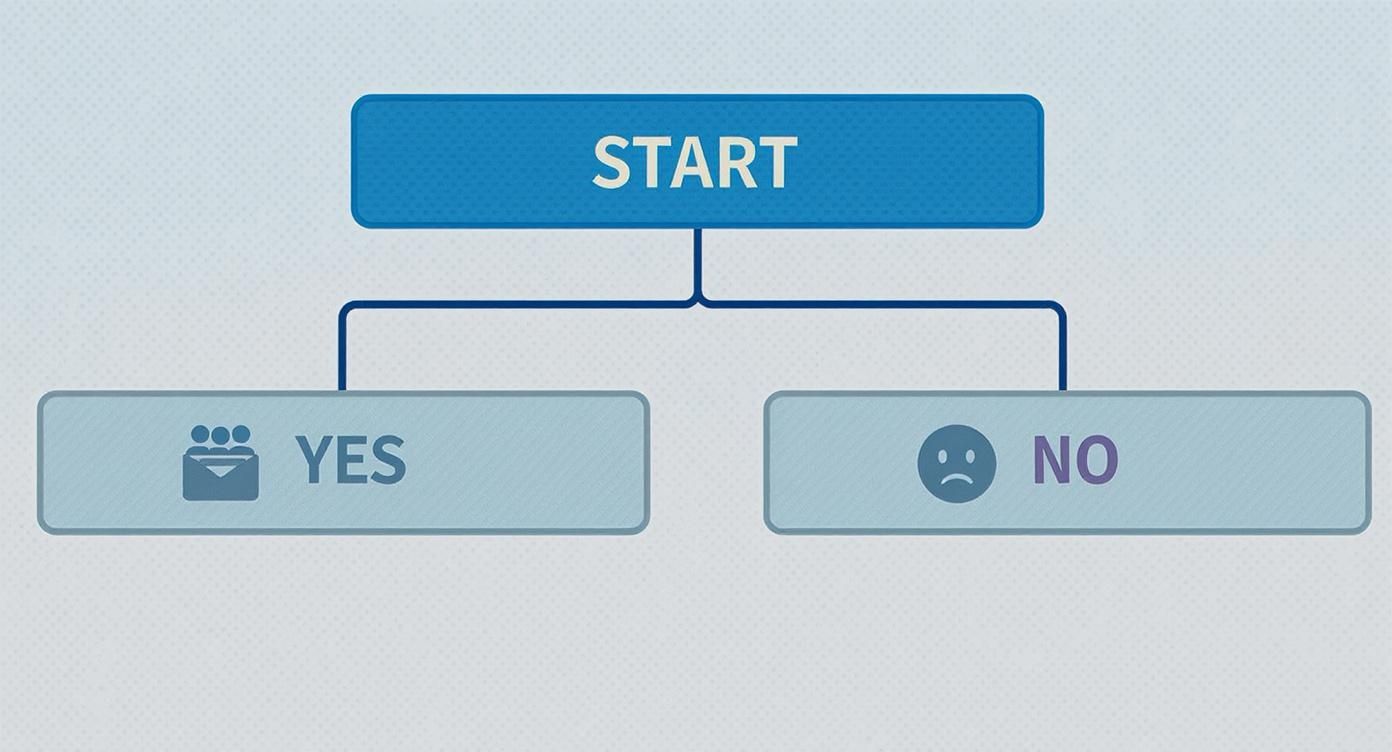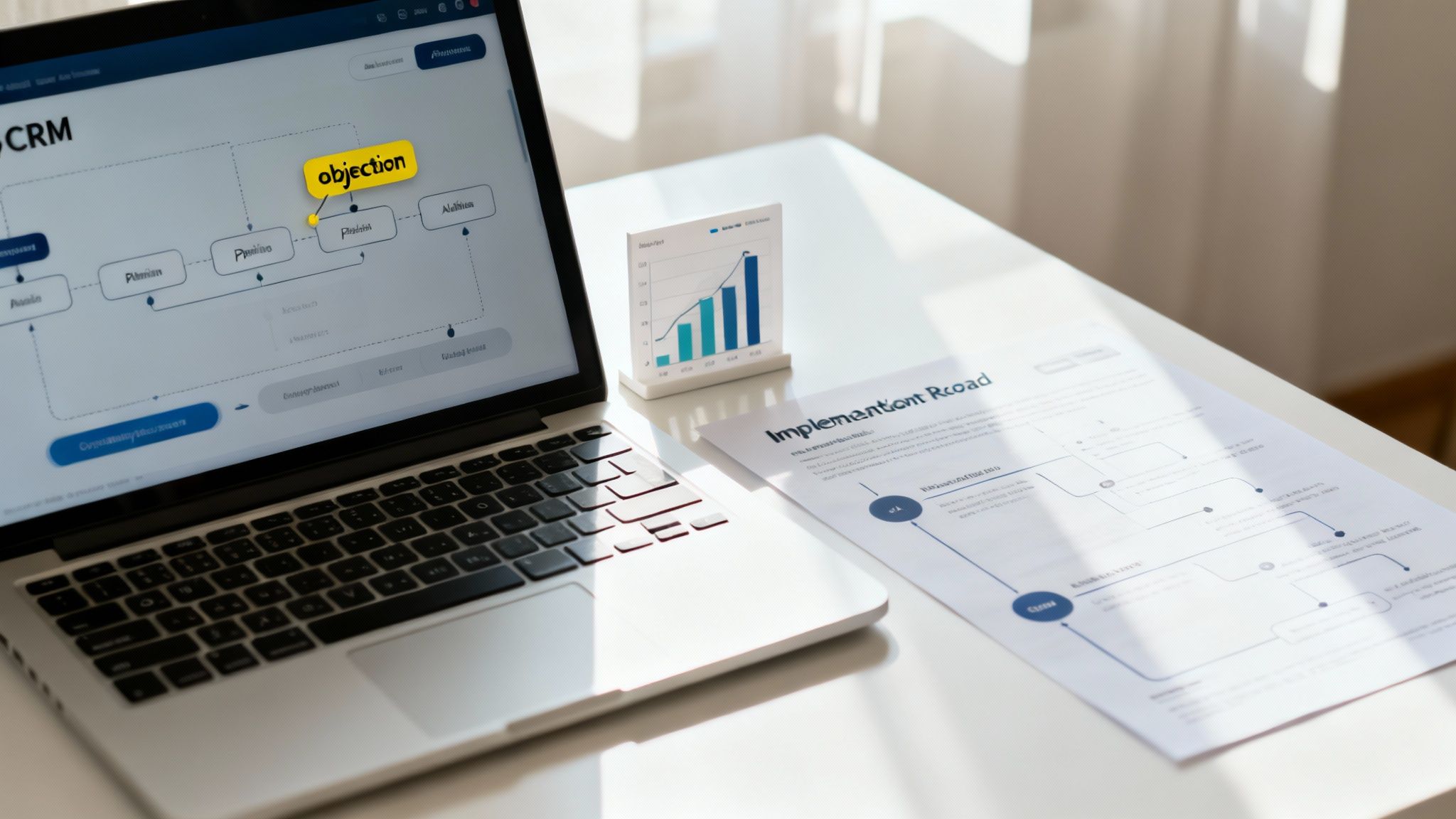Master Spin Selling to Boost Your Sales
Master SPIN selling with this comprehensive guide. Learn the four key question types and proven strategies to close larger deals and enhance sales...
Master overcoming objection in sales with this guide. Learn proven techniques to understand, handle, and convert objections into closed deals.
Let's be honest. Hearing "no" or "not right now" can feel like hitting a brick wall. But what if that wall is actually a door? A successful sales career hinges on this mindset shift—seeing objections as opportunities for a deeper conversation, not as dead ends.
When a prospect raises a concern, they aren't just brushing you off. They're engaging. They’re asking you to fill a gap in their understanding or confidence. It’s a critical moment where you can either build trust or lose it.
Ignoring or arguing with an objection destroys rapport. But if you lean in, you can turn a tense moment into a collaborative problem-solving session.
Top performers don't see objections as rejection. They see them as a sign the buyer is paying attention and just needs more information to feel confident. Overcoming an objection isn't about winning an argument; it's about understanding the hesitation and delivering the value they need.
Mastering this skill has a direct impact on your success. Reps who handle objections well don't just close deals faster; they build stronger client relationships that lead to referrals and repeat business. It's about turning friction into connection.
This comes down to a few core principles:
The goal isn't to counter every point but to diagnose the real issue. An objection about price might actually be a concern about ROI. A timing issue could be a hidden lack of trust.
Effectively navigating these conversations means understanding the difference between what a buyer says and what they truly mean. For a deeper dive into tactics, check out a comprehensive guide on handling B2B sales objections.
Ultimately, handling objections comes down to your ability to communicate value. If you can clearly show how your solution solves their specific pains, you're better equipped to close the value gap that causes hesitation.
In fact, salespeople who master objection handling can see their close rates jump by as much as 64%. Addressing concerns head-on reduces buyer friction and keeps the sales cycle moving.
To get better at overcoming objections, you need to know that every concern falls into one of four buckets: price, timing, trust, and need.
Learning to categorize an objection is the difference between fumbling for a reply and delivering a precise, effective response.
When a prospect says, "We don't have the budget," our gut instinct is to treat it as a price issue. But it could be a timing problem ("we have budget, just not this quarter") or a lack of trust in the ROI. Your job isn't to take their words at face value. It's to diagnose the real issue.
This simple decision flow can help you map out your response when you hit a roadblock.

The key takeaway: an objection isn’t a dead end. It’s an invitation to dig deeper and prove your value.
Here’s a quick guide to help you diagnose the real issue behind a prospect's initial objection.
| Objection Category | What You Hear (Prospect's Words) | What It Really Means (Root Cause) |
|---|---|---|
| Price | "It costs too much." / "That’s not in the budget." | "I don't see enough value to justify this price." |
| Timing | "Call me back next quarter." / "Now isn't a good time." | "This isn't a priority." / "I'm not convinced of the urgency." |
| Trust | "I've never heard of your company." / "I need to talk to my team." | "I'm not confident you, your company, or your product can deliver." |
| Need | "We're happy with what we have." / "We don't have that problem." | "I don't believe the pain you solve is real or significant for us." |
By listening for the subtext, you can move past the surface-level comment and address the real barrier.
Let's start with the two you'll hear most often. Price and timing objections are classic first-line defenses, and they often go hand-in-hand.
Price Objections ("It's too expensive"): This rarely means they can’t find the money. It means they don’t see enough value to justify the cost. Your job is to close the gap between your price and their perceived value.
Timing Objections ("Call me back next quarter"): This can be a genuine issue or a polite brush-off. A real timing problem is specific—like a budget cycle or a project wrapping up. A brush-off is vague. Your goal is to figure out which one it is.
For instance, when a prospect says, "We need to use this budget somewhere else," it sounds like a money problem, but it’s really about priorities. Your job is to reframe your solution as a high-priority investment, not just an expense.
While price and timing are common, trust and need objections are often more serious. If a prospect doesn’t trust you or doesn’t believe they have a problem, no discount will be enough.
Trust Objections ("I've never heard of your company"): This isn't just about brand recognition. It can signal a lack of confidence in you, your product, or your company. Building rapport and providing social proof—like case studies or testimonials—are your best tools here.
Need Objections ("We're happy with our current solution"): This is a direct challenge to your value proposition. The prospect is saying, "The pain you claim to solve doesn't exist for me." This is where sharp discovery skills are critical. You have to ask insightful questions to uncover a problem they may not even recognize yet.
An objection like, "I need to check with my team first," might sound like an authority issue. But it often points to a deeper trust gap. The prospect isn't confident enough to champion your solution internally.
Knowing what is intent data can also give you a head start. By understanding a company's buying signals before the first call, you can anticipate their needs and tailor your message.
By diagnosing the true objection, you move from simply reacting to strategically guiding the conversation.
So, you've identified the type of objection. The next ten seconds are critical. How you react will either open the door to a real conversation or slam it shut. A rushed, defensive answer tells the prospect you weren't listening.
The secret to handling objections isn't a library of comebacks. It’s a solid process.
That’s where the LAER method comes in. It’s a simple, four-part framework that gives you a reliable roadmap: Listen, Acknowledge, Explore, and Respond.

Think of it as a conversational guide. It keeps you calm, shows respect, and helps you get to the real issue before you offer a solution.
When you hear an objection, your first instinct is probably to jump in and correct them. Fight that urge. When you react too fast, you're responding to the surface-level comment, not the real concern.
Instead, pause. Take a breath and give them space to explain their thoughts. This simple act lowers their defenses because it shows respect. They feel heard, and that's the first step to building trust.
Next, verbally acknowledge what they said. This isn't about agreeing with them—it's about validating their perspective. Acknowledging their point builds an immediate bridge of empathy and shows you’re on their side.
Keep it simple and sincere. Phrases like these work wonders:
This small step changes the dynamic from a confrontation into a collaboration. You aren't trying to win an argument; you're working together to find a solution.
This is the most important part of the LAER method. Most initial objections are just smokescreens for deeper issues. A price objection might really be about a lack of trust in the ROI. A timing objection could be a polite way of saying they don't see the urgency.
Your job is to dig deeper with a few open-ended questions to uncover the true barrier.
A prospect's first objection is rarely their real one. It's an invitation to ask better questions. Your goal here is to get to the 'why' behind their statement.
For instance, if they say, "It costs too much," don't immediately defend your pricing. Instead, explore it:
These questions steer the conversation away from a dead-end "yes" or "no" and encourage the prospect to give you context. Getting to the root cause is a core principle in methodologies like SPIN selling, which focuses on asking the right questions.
Only after you’ve listened, acknowledged, and explored should you respond. By now, you should have a clearer picture of what's holding them back. This lets you craft a precise, value-driven answer instead of a canned one.
Your response shouldn't be a monologue. It needs to directly address the root concern you just uncovered, using specific proof points.
For a Price Objection (Rooted in ROI fear): "That makes sense. Another client, [Company Name], had a similar concern. We ran the numbers with them and found that by automating [X process], they saved $15,000 in the first six months. Would an ROI calculator like that be helpful?"
For a Trust Objection (Rooted in company reputation): "I understand wanting to partner with an established name. We're trusted by companies like [Client A] and [Client B]. Here’s a case study showing how we helped them achieve a 40% increase in their pipeline."
For a Timing Objection (Rooted in implementation fear): "I get it, your team is swamped. That’s why we provide a dedicated onboarding specialist and have a clear 30-day implementation plan. Most clients are fully up and running with less than five hours of work from their side."
This tailored response, built on the LAER process, transforms objection handling from a high-pressure tactic into a helpful conversation that builds confidence and moves the deal forward.
The first "no" is almost never the end of the conversation. It's usually the beginning. The art of handling objections isn't about one perfect comeback; it's about mastering the strategic follow-up.
There's a thin line between persistence and being annoying. Cross it, and you'll destroy any rapport you've built. The trick is to shift from "just checking in" to delivering real value with every touchpoint.
Often, a prospect will give you a couple of reasons for their hesitation. "The timing isn't great, and we're not sure about the price." If you try to fight both at once, you’ll get tangled in a conversation that goes nowhere.
This is where the Isolation Technique is your most powerful tool. The goal is simple: uncover the single biggest deal-breaker so you can focus your energy there.
Here’s how it works:
Their answer is gold. If they say, "Well, no, if the price was right, we'd make the timing work," you've isolated the real objection. The timing excuse was just a smokescreen. Now you know where to focus.
Once you've zeroed in on the core objection, your follow-up strategy becomes clear. Instead of sending generic "just checking in" emails, every interaction should offer something useful that speaks to their main concern.
Persistence is only annoying when it's self-serving. When your follow-up provides genuine value, it's seen as helpful, not pushy.
Think about what you can give them to chip away at their hesitation.
This shift changes the dynamic. You're no longer a salesperson chasing a signature; you're a trusted resource helping them solve a problem.
Not every "no" is a secret "yes." Sometimes, an objection is a final decision. The skill is learning to spot the difference between a real objection and a polite brush-off.
A real objection is specific and leaves room for discussion ("We don't have the budget until Q3"). A hard no is vague and final ("We've decided to go in another direction"). Don't burn energy trying to turn a dead end into an open door. Thank them for their time and leave the door open for the future.
This kind of smart persistence is critical because most deals aren't won on the first call. The data is clear: 60% of customers say “no” up to four times before they finally agree to a sale. And 80% of sales require at least five follow-ups to close.
These numbers prove how vital a persistent, value-driven follow-up is. If you want to dig deeper, you can read about the science of handling objections in sales. By treating every objection as an opportunity to understand their needs better, you can turn a delayed decision into a win.
Handling an objection well in the moment is a solid skill. But turning that skill into a repeatable, systematic process is what separates top sales teams from everyone else.
Great objection handling isn't just a tactic for a tough call. It's a strategy you should build directly into your workflow. This is how you move from clever comebacks to a proactive system using your CRM and sales methodology.
The same objections pop up again and again. By tracking them, you turn anecdotes into data. This is where your CRM becomes your secret weapon for getting ahead of objections.
Your CRM should be more than a contact list. It needs to be a database of your buyer's worries.
Start by creating a field or tag to log the type of objection you hit on a lost or stalled deal—price, timing, trust, scope. It’s a small change that builds an incredibly powerful dataset.
After a few weeks, you can run a report and spot patterns.
This data lets you shift from reacting to anticipating. For example, if you see that 70% of prospects in an industry push back on price, you can proactively build a stronger ROI case into your initial discovery calls with everyone in that segment.
By tracking objections as a data point in your CRM, you stop guessing and start knowing. This intelligence fuels smarter discovery, more relevant messaging, and a more strategic sales cycle.
This level of preparation is a huge part of a successful sales enablement framework. You're not just handling objections; you're systematically dismantling them before they gain traction.

If your team uses a methodology like MEDDICC, integrating objection handling becomes even more powerful. Each letter in the framework gives you a new angle to address concerns. Instead of a generic response, you can tie your rebuttal directly to the business drivers you've already uncovered.
Here’s how it works.
Metrics (M)
When a prospect objects to the price, your first move is to bring up their Metrics. You’ve already identified their quantifiable goals, like boosting revenue by 15% or cutting churn by 10%.
Decision Criteria (D)
Every buyer has a checklist of what they need. When you hear an objection about features, it's a signal to revisit their Decision Criteria.
This approach turns a defensive conversation into a strategic one. You’re reminding the buyer of their own priorities and connecting your solution to what they’ve already told you matters most.
By embedding objection handling into frameworks like MEDDICC and using your CRM, you create a powerful feedback loop. It makes your entire sales process smarter, more predictable, and more effective at turning hesitation into commitment.
Even with the best frameworks, you'll get curveballs that leave you wondering what to say. Let's dig into a few common questions reps have, with some quick advice for your next call.
Hands down, it's price. "It's too expensive" is a classic. The best way to handle this is to reframe the conversation around value and ROI, not the sticker price.
Don't get defensive. Get curious. Ask clarifying questions like, "That's a fair point. Compared to what?" or "Putting cost aside for a moment, do you feel this solution solves the problem we've been talking about?" This shifts the dynamic from an expense to an investment. Your goal is to get them thinking about the cost of inaction—what happens if this problem is still there six months from now?
The difference is specificity. A brush-off is vague and dismissive. Think "I'm not interested" or "Just send me information." It’s designed to end the conversation quickly.
A real objection gives you something to work with. It's more specific: "We don't have the budget until next quarter" or "Your solution is missing a key integration."
To figure out which one you're dealing with, use the 'Isolate and Validate' technique.
Acknowledge what they said and ask, "If [the stated objection] wasn't an issue, would you be ready to move forward?" Their answer will tell you everything. It instantly reveals if their reason is a genuine concern or just an excuse.
This is a classic stall, and it usually hides a deeper objection. If you accept it at face value, you'll end up in follow-up purgatory. The key is to gently encourage them to reveal their real hesitation.
A great response is, "That's fine. So I know what to prepare for our next conversation, what specific aspects of our proposal will you be thinking about?"
This simple question turns a vague delay into a concrete discussion. It prompts them to share what's really on their mind—whether it's price, features, or internal politics—and gives you something specific to solve.
Ready to turn every objection into an opportunity? Salesmotion uses AI to monitor account signals 24/7, giving you the context you need to anticipate and address concerns before they ever come up. Learn more at Salesmotion.
Master SPIN selling with this comprehensive guide. Learn the four key question types and proven strategies to close larger deals and enhance sales...
Unlock your B2B sales potential. This guide reveals how to identify, engage, and persuade the economic buyer—the ultimate decision-maker.
Discover how sales enablement consulting optimizes your B2B sales process, boosts win rates, and drives measurable revenue growth for your team.